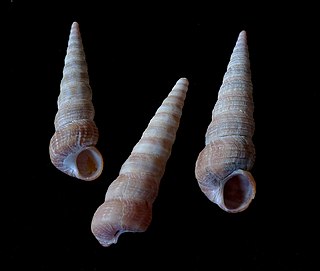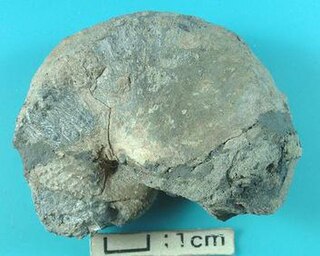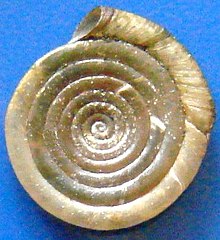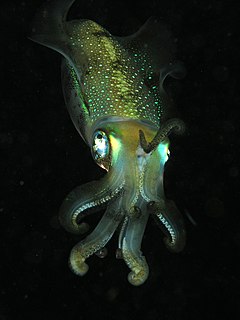
Ammonoids are an extinct group of marine mollusc animals in the subclass Ammonoidea of the class Cephalopoda. These molluscs, commonly referred to as ammonites, are more closely related to living coleoids than they are to shelled nautiloids such as the living Nautilus species. The earliest ammonites appear during the Devonian, and the last species died out in the Cretaceous–Paleogene extinction event.

The Nautilida constitute a large and diverse order of generally coiled nautiloid cephalopods that began in the mid Paleozoic and continues to the present with a single family, the Nautilidae which includes two genera, Nautilus and Allonautilus, with six species. All told, between 22 and 34 families and 165 to 184 genera have been recognised, making this the largest order of the subclass Nautiloidea.

Goniatids, informally Goniatites, are ammonoid cephalopods that form the order Goniatitida, derived from the more primitive Agoniatitida during the Middle Devonian some 390 million years ago. Goniatites (goniatitida) survived the Late Devonian extinction to flourish during the Carboniferous and Permian only to become extinct at the end of the Permian some 139 million years later.

The term ramshorn snail or ram's horn snail is used in two different ways. In the aquarium trade it is used to describe various kinds of freshwater snails whose shells are planispiral, meaning that the shell is a flat coil. Such shells resemble a coil of rope, or a ram's horn. In a more general natural history context, the term "ramshorn snails" is used more precisely to mean those aquatic pulmonate gastropod mollusks in the family Planorbidae that have planispiral coiled shells.

A whorl is a single, complete 360° revolution or turn in the spiral growth of a mollusc shell. A spiral configuration of the shell is found in of numerous gastropods, but it is also found in shelled cephalopods including Nautilus, Spirula and the large extinct subclass of cephalopods known as the ammonites.

A spire is a part of the coiled shell of molluscs. The spire consists of all of the whorls except for the body whorl. Each spire whorl represents a rotation of 360°. A spire is part of the shell of a snail, a gastropod mollusc, a gastropod shell, and also the whorls of the shell in ammonites, which are fossil shelled cephalopods.
Ismailia is a genus of foraminifera with an agglutinated, planispirally coiled, semi-involute shell, known from the Egyptian Sinai, that lived during the early part of the Late Cretaceous (Cenomanian). Agglutinated shells are composed of selected foreign material cemented together.

The umbilicus of a shell is the axially aligned, hollow cone-shaped space within the whorls of a coiled mollusc shell. The term umbilicus is often used in descriptions of gastropod shells, i.e. it is a feature present on the ventral side of many snail shells, including some species of sea snails, land snails, and freshwater snails.

Mizuhobaris is an extinct genus of shelled octopods from the Late Miocene.

The gastropod shell is part of the body of a gastropod or snail, a kind of mollusc. The shell is an exoskeleton, which protects from predators, mechanical damage, and dehydration, but also serves for muscle attachment and calcium storage. Some gastropods appear shell-less (slugs) but may have a remnant within the mantle, or the shell is reduced such that the body cannot be retracted within (semi-slug). Some snails also possess an operculum that seals the opening of the shell, known as the aperture, which provides further protection. The study of mollusc shells is known as conchology. The biological study of gastropods, and other molluscs in general, is malacology. Shell morphology terms vary by species group. An excellent source for terminology of the gastropod shell is "How to Know the Eastern Land Snails" by John B. Burch now freely available at the Hathi Trust Digital Library.

Planorbidae, common name the ramshorn snails or ram's horn snails, is a family of air-breathing freshwater snails, aquatic pulmonate gastropod molluscs. Unlike most molluscs, the blood of ram's horn snails contains iron-based hemoglobin instead of copper-based hemocyanin. As a result, planorbids are able to breathe oxygen more efficiently than other molluscs. The presence of hemoglobin gives the body a reddish colour. This is especially apparent in albino animals.
Gyraulus riparius is a species of small freshwater snail, an aquatic pulmonate gastropod mollusk in the family Planorbidae, the ram's horn snails.
Gyraulus rossmaessleri is a small species of freshwater snail, an aquatic pulmonate gastropod mollusk in the family Planorbidae, the ram's horn snails.

Gyraulus laevis is a small species of freshwater snail, an aquatic pulmonate gastropod mollusc in the family Planorbidae, the ram's horn snails.

Bellerophontoidea,, common name "bellerophonts", is a superfamily of extinct planospirally-coiled globose molluscs. This superfamily is generally included within the Gastropoda, but may instead be a group of monoplacophorans. The taxon first appeared late in the Cambrian and continued until late in the Triassic.
Bucanellidae is an extinct family of Paleozoic molluscs of uncertain position, belonging either to Gastropoda (snails) or Monoplacophora. The family lived from the upper Cambrian to middle Permian and the shells are characterized by a relatively small median sinus in the upper margin of the aperture, and collabral (transverse) or spiral (longitudinal) threads covering the shell. The shells are planispirally coiled rather than trochospirally with a spire as is the case with most shelled gastropods.

Macroscaphites is an extinct cephalopod genus included in the Ammonoidea that lived during the Barremian and Aptian stages of the Early Cretaceous. Its fossils have been found throughout most of Europe and North Africa.
Nodosariacea is one of two superfamilies making up the foraminiferal order Lagenida. The other being the Robuloidacea. Of these two Nodosariacea is the more advanced, as well as being the younger.
Sigmoilinopsis is a genus of miliolid Foraminifera, with an ovate test, chambers one-half coil in length, arranged in rapidly changing planes in the early stage resulting in two spiralling series that appear sigmoid in section, gradually becoming planispiral in the adult. Walls are thick, porcelaneous but enclosing a large quantity of agglutinated quartz particles, sponge spicules, and shell fragments; the aperture terminal, rounded, with a small tooth.
Streptocyclammina is a genus of benthic forams with a flattened test from the Jurassic. The test usually starts off streptospiral hence the name, and becomes planispiral in the mature stage. Chambers are numerous per whorl, whorls become rapidly larger in peneropline fashion. Sutures between whorls are slightly indented, the periphery rounded. The wall is finely agglutinated, externally imperorate, internally with massive septa perforated by numerous apertures.

















